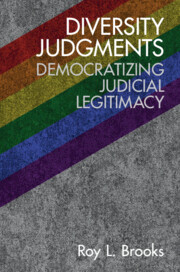Book contents
- Diversity Judgments
- Diversity Judgments
- Copyright page
- Dedication
- Contents
- Preface
- Acknowledgments
- Introduction
- Part I Asian Americans
- Part II African Americans
- Part III Women
- Part IV Latinx
- Part V Native Americans
- Part VI LGBTQ
- Part VII Intersectionality
- Part VIII Outsiders v. Outsiders
- Part IX White Males
- Part X Situational Outsiders
- 21 Gideon v. Wainwright (Right to Counsel)
- 22 Martin v. City of Boise (the Homeless)
- 23 Citizens United v. FEC (Campaign Financing)
- 24 Trump v. Int’l Refugee Assistance Project (Muslim Immigration)
- Index
23 - Citizens United v. FEC (Campaign Financing)
from Part X - Situational Outsiders
Published online by Cambridge University Press: 10 March 2022
- Diversity Judgments
- Diversity Judgments
- Copyright page
- Dedication
- Contents
- Preface
- Acknowledgments
- Introduction
- Part I Asian Americans
- Part II African Americans
- Part III Women
- Part IV Latinx
- Part V Native Americans
- Part VI LGBTQ
- Part VII Intersectionality
- Part VIII Outsiders v. Outsiders
- Part IX White Males
- Part X Situational Outsiders
- 21 Gideon v. Wainwright (Right to Counsel)
- 22 Martin v. City of Boise (the Homeless)
- 23 Citizens United v. FEC (Campaign Financing)
- 24 Trump v. Int’l Refugee Assistance Project (Muslim Immigration)
- Index
Summary
The first push for regulating money in politics began in the decades after the Civil War. Americans became concerned about the power “organized money,” a phenomenon created during the Industrial Revolution, exerted over the democratic process. “The oft-stated charge was, ‘America in making her fortune was in peril of losing her soul.’” Congress passed the first major campaign-finance legislation in 1906, the Tillman Act, prohibiting corporations from using “stockholders’ money” for political contributions. The thrust for this legislation came in response to President Roosevelt’s acceptance of corporate contributions in the presidential election of 1904. President Roosevelt bowed to public pressure and publicly supported campaign finance reform. The New York Times reported that, “One ‘great financial authority who is a Republican’ gave assurance that ‘he and all the financial men with whom I have talked have welcomed this legislation with very much the same emotions with which a serf would hail his liberation from a tyrannous autocrat.’”
- Type
- Chapter
- Information
- Diversity JudgmentsDemocratizing Judicial Legitimacy, pp. 558 - 582Publisher: Cambridge University PressPrint publication year: 2022

